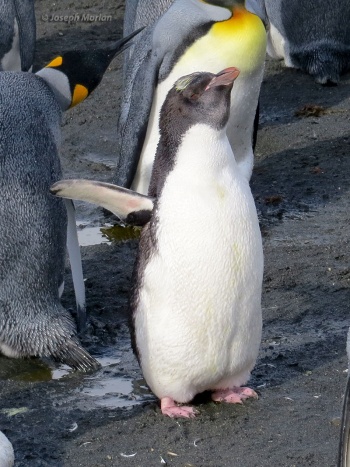- Eudyptes chrysolophus
Identification
L. 71 cm. (28")
Adult
Large, yellow-crested, black-and-white penguin. Black upperparts. White underparts froming a black V on throat. Dark grey to black head and cheeks. Long yellow, orange and black plumes project from forehead patch back along crown and droop behind eye. Bill red-brown with pink fleshy margin at base, feet pink with black soles.
Juvenile
Head plumes pale and much reduced, not meeting at the forehead.
Similar species
Royal Penguin (E. schlegeli) is the only other penguin with crests that meet on the forehead. Royal Penguin has pure white to pale grey cheeks, but light-faced Macaroni Penguins have been reported at some sites. It is not known whether these are local mutations or hybrids. Southern Rockhopper Penguin (E. chrysocome) is smaller, has erectile head plumes, thin yellow supercilium which does not meet over forehead, lacks fleshy gape margins and lacks pointed division between black and white on throat.
Distribution
Subantarctic islands in South Atlantic Ocean and South Indian Ocean: Antarctica; Argentina; Bouvet Island; Chile; Falkland Islands (Malvinas); French Southern Territories; Heard Island and McDonald Islands; South Africa; South Georgia South Shetland, South Orkney and South Sandwich Islands.
Vagrant to Australia; Brazil; New Zealand; Saint Helena, Ascension and Tristan da Cunha
Taxonomy
Habitat
Rocky islands for breeding; pelagic otherwise.
Behaviour
Diet
Macaroni penguins are pelagic foragers. Their diet includes crustaceans, particularly krill, small fish and squid.
Nesting
They nest on level to steep ground, often walking hundreds of metres across steep scree slopes to inland nest-sites. They build a nest of mud, small stones and grass. Breeding is highly synchronous within each colony. 1-3, chalky-white or pale bluish or greenish-white eggs are laid in mid-November. Incubated by both parents. Young fed by female and guarded by male but only one usually raised.
Voice
At colonies, repeated loud braying, raucous trumpeting (lower pitched in males) with head swinging and flipper beating. Short barking for contact.
References
- Clements, J. F., T. S. Schulenberg, M. J. Iliff, D. Roberson, T. A. Fredericks, B. L. Sullivan, and C. L. Wood. 2017. The eBird/Clements checklist of birds of the world: v2017, with updates to August 2017. Downloaded from http://www.birds.cornell.edu/clementschecklist/download/
- BirdLife International. 2017. Eudyptes chrysolophus (amended version of 2016 assessment). The IUCN Red List of Threatened Species 2017: e.T22697793A110669422. http://dx.doi.org/10.2305/IUCN.UK.2017-1.RLTS.T22697793A110669422.en. Downloaded on 08 June 2018.
- Jaramillo, A. 2003. Birds of Chile. Princeton & Oxford: Princeton Univ. Press. ISBN 978-0691117409
- Martínez, I., Christie, D.A. & Jutglar, F. (2018). Macaroni Penguin (Eudyptes chrysolophus). In: del Hoyo, J., Elliott, A., Sargatal, J., Christie, D.A. & de Juana, E. (eds.). Handbook of the Birds of the World Alive. Lynx Edicions, Barcelona. (retrieved from https://www.hbw.com/node/52466 on 8 June 2018).
- Shirihai, H. 2008. Complete Guide to Antarctic Wildlife: Birds and Marine Mammals of the Antarctic Continent and the Southern Ocean. Princeton & Oxford: Princeton Univ. Press. ISBN 978-0691136660
Recommended Citation
- BirdForum Opus contributors. (2025) Macaroni Penguin. In: BirdForum, the forum for wild birds and birding. Retrieved 25 April 2025 from https://www.birdforum.net/opus/Macaroni_Penguin






